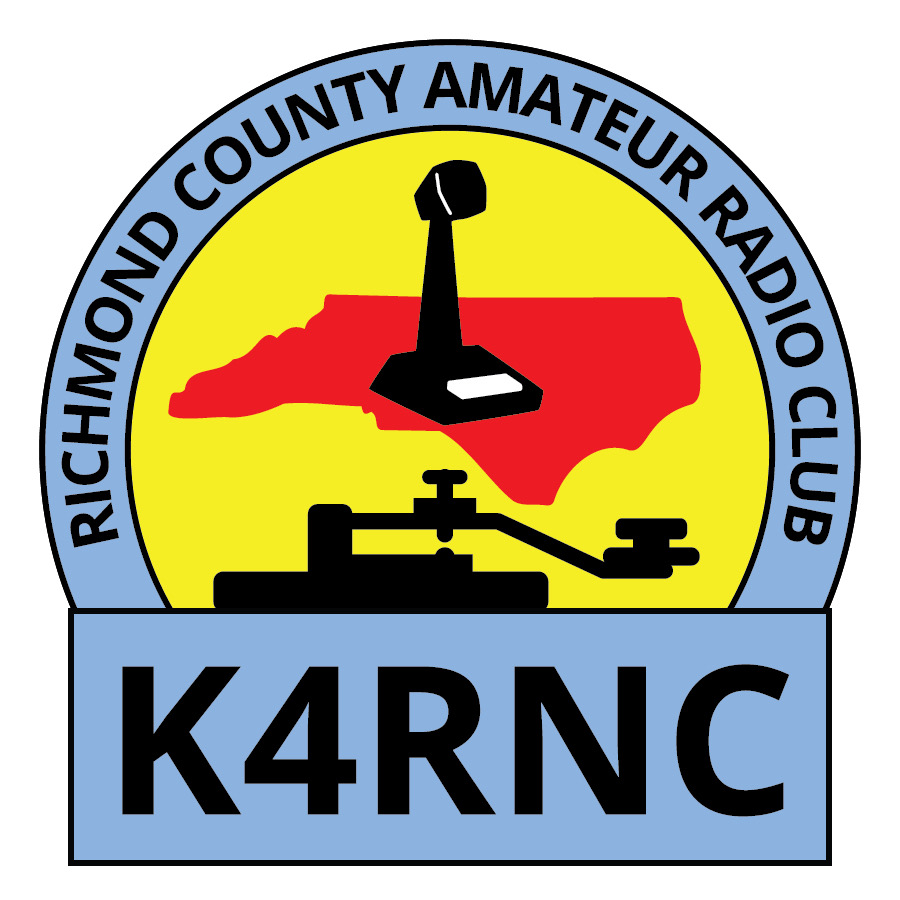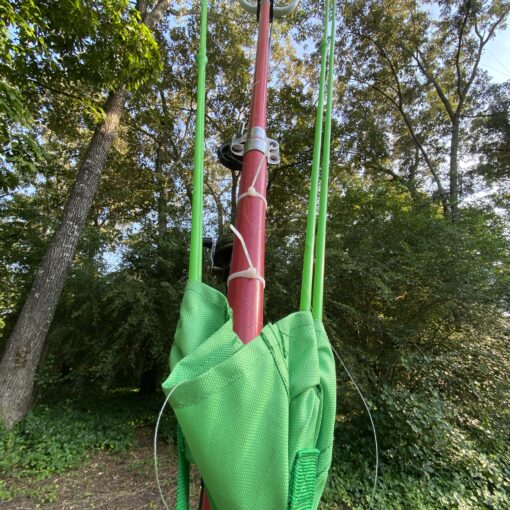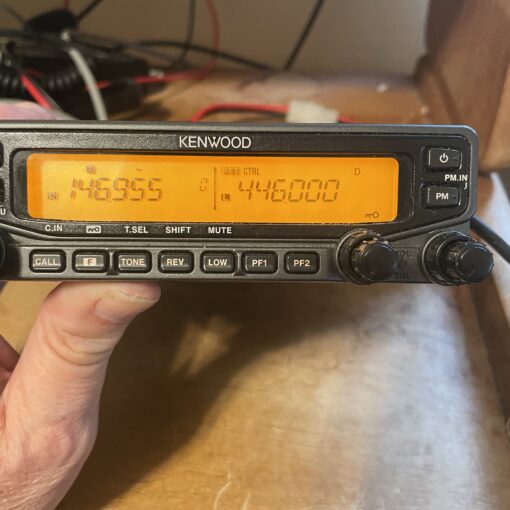
Simply put, a repeater is an automated radio with an antenna high up on a tower that receives a transmission and simultaneously repeats it out, extending the range of the received signal.
Every radio has a limited range. A 5-watt HT (handheld transceiver) may only reach a mile or two. If it can reach the repeater, the HT’s signal will be retransmitted at 50 or 100 watts from an antenna hundreds of feet in the air potentially reaching 50-100 miles.
Even a strong mobile or base station radio has limits. If a base station 30 miles away from the repeater can reach the repeater, that signal is sent out again from a greater height and may reach another 50-100 miles.
Repeaters work on fixed frequencies and are coordinated regionally to ensure they don’t interfere with each other. RCARC’s repeater transmits on 146.955 MHz.
Offsets
A radio can’t receive and transmit on the same frequency at the same time so, repeaters use an offset frequency to receive. The standard offset for 2-meter repeaters is 6kHz.
RCARC’s repeater uses a negative offset so it receives at 146.355 MHz, which is 6kHz lower than the transmit frequency, -6kHz offset. Because 6kHz is a standard offset for the 2-meter band, references to the repeater will often refer to the negative offset without mentioning the 6kHz. You may see it as 146.955- in some online references.
A radio properly setup to operate the repeater will be tuned to 146.955. When an operator keys up to transmit from their radio to the repeater, their radio will drop down 6kHz to 146.355 while they are keyed up and talking. As soon as they release the mic, their radio will jump back to listening on 146.955.
While this is happening, the repeater is receiving the transmission on 146.355 and simultaneously transmitting it out on 146.955 for everyone to hear. As you talk into your mic, the repeater is both receiving your transmission AND sending it out for everyone else to hear. Offsets make that possible.
Tones
Radios receive interference sometimes. It could be anything but we wouldn’t want the repeater to send out interference that it receives. To prevent that, many repeaters use CTCSS tones, commonly called PL tones. Many walkie-talkie style family radios or GMRS radios will also use these tones, sometimes calling them “privacy tones” or something similar.
PL stands for Private Line and is a proprietary Motorola term. It’s also a misleading. Using a PL tone doesn’t provide privacy. It doesn’t keep people from hearing your transmission. What it does is prevent other people from interrupting your transmission with a transmission of their own. Using a tone keeps others from breaking in to your conversation but they can still hear you.
A more accurate and descriptive term is CTCSS but it’s also longer and more cumbersome, so most people use PL tone. CTCSS stands for Continuous Tone Coded Squelch System. They’re two names for the exact same thing.
What is a CTCSS tone? As the name implies, it’s a tone that is continually sent when a radio transmits. It’s a high-pitched whine that is transmitted with your voice. It’s high enough that it’s beyond human hearing, you won’t notice it, but the receiving radio can hear it.
A squelch system squelches or silences a signal. The tone allows a signal to break through the squelch, acting like a password or key. A signal without the tone will be squelched, silenced or ignored.
What does a CTCSS tone do? Why use one?. When a radio requires a CTCSS tone, a transmitting radio will need to be on the correct frequency AND transmit the correct CTCSS tone before the receiving radio will receive it.
For example, the RCARC repeater is set to receive on 146.355 and require a 88.5MHz tone. If my radio transmits on 146.355 without the tone or with the wrong tone, the repeater will ignore it. Nothing will be received by the repeater.
If my radio transmits on 146.355 with the 88.5kHz tone, I won’t hear the tone but the repeater will and it will receive my transmission and repeat it out for others to receive.
This is how the repeater is able to ignore interfering signals. Interference won’t have the CTCSS tone and won’t be received by the repeater, even if it’s on the repeater’s receive frequency.
So, to use a repeater, it’s necessary to set the correct frequency, the correct offset AND the correct tone if the repeater uses one.
We’re more than happy to help you setup your radio to work with the repeater and, in addition to the RCARC repeater, there are several others in the area you may want to program. We can help.
Repeater Etiquette, Dos and Don’ts
Repeaters aren’t just for nets. They’re always on and a great way to extend the reach of your radio but general repeater use is a little different than simplex.
Simplex
Another term you may hear in conversations about repeaters is simplex. Talking simplex means communicating directly from one operator’s radio to another operator’s radio without the use of a repeater.
Always listen first. This is good practice any time you tune up on a frequency but especially on a repeater. Listen for a minute to hear if there’s an ongoing conversation.
If there’s a conversation and you’d like to join in, wait for a pause and throw out your call sign. If you’re heard, they’ll likely invite you in.
If there’s nothing going on and you’re open to a conversation, call out with “[your call sign] listening on 146.955.” Using your call sign is a must. Listening lets people know you’re open to conversation. Giving the frequency lets anyone using a scanner know what frequency you’re on so they can come back to you.
Any time you key up on a repeater (transmit), for the first time, give your call sign. Even if you’re just checking to see if your radio is working and programmed correctly. If I’m checking my radio program to see if it’s hitting the repeater, I’ll say “KA4AMP testing.”
Keying up a repeater without IDing is not only an FCC violation, it’s rude and a good way to irritate others listening to the repeater. We’d rather hear 10 radio checks with a call sign than one empty key up, also called a “kerchunk.”
Don’t use CB lingo. Amateur radio is an international hobby. CB lingo can mean many different things to many different people. Use plain language and the learn the lingo common to amateur radio. Terms like “breaker, breaker” and “10-4” will irritate people and may even earn some verbal correction. Generally speaking, if it sounds like something you’d hear on the CB, don’t use it on amateur radio.
Saying goodbye
Whether you’re on a repeater or talking simplex, the most common way to end a conversation is their call sign, your call sign and “73”. The use of 73 comes from CW (morse code) and is an abbreviated and polite way to say, “I’ve got to go but it’s been nice, hope to talk with you again sometime.” All of that in two digits, 73.
by Mike Litty KA4AMP


